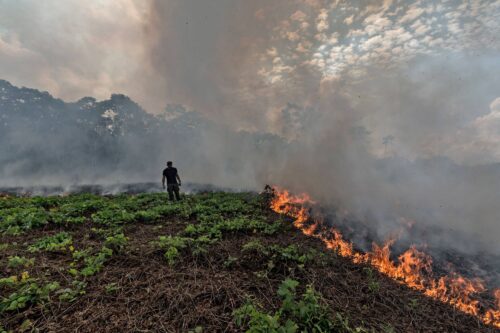The Impact of Deforestation on Climate Change. Deforestation and climate change are deeply intertwined, with one significantly influencing the other.
In this article, we delve into the critical relationship between deforestation and climate change, exploring the various ways in which deforestation exacerbates global warming and the subsequent impacts on our planet.
Understanding Deforestation
Deforestation is the process of clearing large areas of forests, primarily for agriculture, logging, and urbanization. As trees are felled, the carbon stored within them is released into the atmosphere in the form of carbon dioxide (CO2), a potent greenhouse gas. The loss of trees also reduces the Earth’s capacity to absorb CO2, leading to an increase in the concentration of greenhouse gases and contributing to the greenhouse effect.
The Greenhouse Effect and Climate Change
The greenhouse effect is a natural phenomenon that regulates the Earth’s temperature. Certain gases, including CO2, trap heat in the atmosphere, preventing it from escaping into space. This process is vital for maintaining a stable and habitable climate. However, human activities, such as deforestation and burning fossil fuels, have intensified the greenhouse effect, leading to global warming and climate change.
Amplifying Global Warming
Deforestation plays a significant role in amplifying global warming. Trees act as carbon sinks, absorbing CO2 from the atmosphere during photosynthesis and storing it in their trunks and roots. When forests are cleared, the stored carbon is released back into the atmosphere, accelerating the greenhouse effect. Additionally, the absence of trees reduces the amount of water vapor released through a process called transpiration, which further contributes to climate change by affecting cloud formation and precipitation patterns.
Altered Weather Patterns
The impact of deforestation on climate change extends to altering weather patterns. Forests play a crucial role in regulating local and regional climates. They create a cooling effect by providing shade and releasing moisture into the atmosphere through transpiration. With deforestation, there is a reduction in the cooling effect, leading to higher temperatures in affected areas and influencing weather patterns, such as increased instances of heatwaves and droughts.
Loss of Biodiversity
Deforestation not only affects climate change but also results in the loss of biodiversity. Forests are incredibly diverse ecosystems that house a vast array of plant and animal species. When forests are cleared, many species lose their habitats, leading to extinction or migration. The loss of biodiversity disrupts delicate ecological balances and can have far-reaching consequences on the environment and human communities.
Solutions for Mitigation
To combat the adverse effects of deforestation on climate change, we must take immediate action. Implementing sustainable forest management practices, promoting reforestation efforts, and supporting conservation initiatives are essential steps in mitigating deforestation’s impact. Embracing renewable energy sources and reducing carbon emissions are also vital components of the solution.
Deforestation’s Impact on Climate Change
Conclusion
In conclusion,the relationship between deforestation and climate change is undeniable. The clearing of forests not only releases vast amounts of CO2 into the atmosphere but also disrupts weather patterns and leads to the loss of biodiversity. Urgent action is required to mitigate the impacts of deforestation on climate change. By understanding the consequences and embracing sustainable practices, we can pave the way towards a more resilient and sustainable future for our planet. Let us work together to protect our forests and combat climate change for the well-being of current and future generations.



